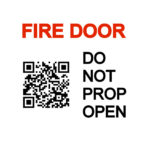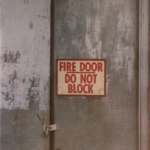 Yesterday I stopped for breakfast with a deputy state fire marshal as I drove through South Carolina on my way from our office in Charlotte to our office near Atlanta. He barely had a chance to eat, as I was picking his brain about all of the things I’ve had on my mind for years. I’ll be doing some virtual training for code officials next year, and I want to make sure that I cover their most frequently-asked questions. It was a great opportunity to get some of his topics on the list.
Yesterday I stopped for breakfast with a deputy state fire marshal as I drove through South Carolina on my way from our office in Charlotte to our office near Atlanta. He barely had a chance to eat, as I was picking his brain about all of the things I’ve had on my mind for years. I’ll be doing some virtual training for code officials next year, and I want to make sure that I cover their most frequently-asked questions. It was a great opportunity to get some of his topics on the list.
One of the things we talked about was the need for firefighter access to buildings, and the problems associated with “exit-only” hardware. I can imagine the frustration when firefighters arrive on scene and are met with a door that has no exterior hardware to allow them to access that area of the building. With that said, when I was a specwriter it was common to specify emergency exits without exterior hardware.
I checked the International Fire Code (IFC) for a requirement for firefighter access doors, to see if there were specific locations or quantities of exterior doors that need – at minimum – outside key cylinders. Section 504 of the 2021 IFC addresses Access to Building Openings and Roofs:
504.1 Required access. Exterior doors and openings required by this code or the International Building Code shall be maintained readily accessible for emergency access by the fire department. An approved access walkway leading from fire apparatus access roads to exterior openings shall be provided where required by the fire code official.
504.2 Maintenance of exterior doors and openings. Exterior doors and their function shall not be eliminated without prior approval. Exterior doors that have been rendered nonfunctional and that retain a functional door exterior appearance shall have a sign affixed to the exterior side of the door with the words “THIS DOOR BLOCKED.” The sign shall consist of letters having a principal stroke of not less than 3/4 inch (19.1 mm) wide and not less than 6 inches (152 mm) high on a contrasting background. Required fire department access doors shall not be obstructed or eliminated. Exit and exit access doors shall comply with Chapter 10. Access doors for high-piled combustible storage shall comply with Section 3206.7.
In this section it doesn’t specifically say that the doors must have hardware on the exterior, but it sure reads as if the intent of the code is for required exterior doors to allow fire department access. It would be much easier and less destructive to facilitate this with a key or electronic credential in the key box rather than by using other means to breach the door.
Section 3206.7, which addresses fire department access doors for high-piled combustible storage areas, includes more specific requirements for the these doors. The code defines the required locations of fire department access doors and requires them to be shown on the construction documents. The lineal distance between the doors must be no more than 125 feet measured center-to-center, with the exception of existing buildings where the doors may be a maximum of 200 feet apart. The doors must be at least 3 feet wide x 6 feet 8 inches high, and must have signage on the exterior to identify them as fire department access doors. The locking devices must be “approved” (acceptable to the fire code official), and the IFC Commentary states:
Locking mechanisms must be approved by the fire code official. The fire service must be able to open the doors from the exterior side during an emergency. The locking mechanism must be designed to maintain the security of the building, to be readily openable from the egress side and to be openable by fire department personnel from the exterior.
This section of the IFC also requires key boxes to be installed, and to contain keys or devices to allow entry through the fire department access doors.
If areas with high-piled combustible storage are required to have fire department access doors with hardware on the exterior to allow access, doesn’t it seem like doors to other types of buildings should have the same requirements?
Do you typically specify/supply/install hardware on the exterior doors to allow firefighter access?
Maybe this should be on my wish list for the next edition of the IFC?
WWYD?
You need to login or register to bookmark/favorite this content.









Shamefully, I never even thought about fire fighter access. I always suggest a storeroom function exterior trim keyed to the master for the ease of maintenance staff.
I never understood why EO doors had no trim at all.
at least now I have a better point to argue why the client should have exit trim on exterior doors.
thank you
Hi James –
I think exit only hardware is used for either cost savings or security, but adding a cylinder on the outside should not have a huge impact on either of those.
– Lori
Hi Lori,
Here in California, people like to use exit only devices to utilize CBC 11-206.4.1 Exception #2. For example, at a dock high building, usually only the front door is on an accessible path but doors on the sides and back are needed for fire department access. The CBC requires all entrance to be on an accessible path so, if we can show the door is not an entrance (no exterior hardware) then we can utilize exceptions available only to exits.
Whether or not the fire department will accept that is obviously dependent on the fire department! I’ve seen some accept just the dead bolt and the door is opened by turning the key and pulling on the key itself instead of a lever or handle.
Oh – that’s interesting!
– Lori
EO doors are a great addition to pair openings.
In the interest of safe schools, PASS recommends that exterior doors are classified as primary, secondary or tertiary. Perhaps there needs to be an additional category for emergency access or emergency access could be added to the tertiary category. These doors would be keyed or credentialed so only emergency responders could open and would have only a cylinder and maybe a cylinder pull.
Hi Mark –
I definitely think it would be worth adding a recommendation for keyed or credentialed access on some exterior doors that might otherwise be exit-only.
– Lori
I have been in this situation and had to send an RFI to the Architect and see what they think. If they tell me to proceed with no key access, at least we tried and have written information in the job file. Always try to get the answer from the Owner and not just the Architect. If they come back later later, we will be paid for whatever they need. Saved us more than once.
That sounds like a great strategy.
– Lori
Good idea! I have one additional thought.
I am not a spec writer but I have phrased the idea this way for the past ten years since an AHC highlighted it to me:
“We recommend “exit only” doors include hardware specified for emergency ingress of first responders.”
I’m not often involved in high-level design discussions, but I have never had a design team argue that point or reject it. Highlighting a missing detail may have greater success than presenting it as an add-on.
Sounds great!
– Lori
Lori,
I use section 504 of the IFC 2018 to mandate exterior door hardware on all required exit doors. It clearly states that all exterior doors required by the IFC or IBC must be readily accessible for fire department access/entry. The key is making them aware of it prior to installing exit locking hardware only.
Hi Donnie –
Do you think it would be helpful to have more prescriptive language in this section, similar to what is in the high-piled combustible storage section?
– Lori
It may not hurt, however, I think its clear enough to me that where an exit door is required, it should have exterior hardware. Other doors may be allowed to have no exterior hardware where approved by the FCO could be added.
Most of our facilities have multiple exterior doors with only 2 maybe 3 with exterior hardware. This is for security of the building with nothing to grab and pull from the outside.
This configuration has never stopped the Fire Department from pulling a door open and accessing the building. They have tools just for this job.
Hi John –
Do the doors have key cylinders or is the door destroyed in the process of the fire department using their tools?
– Lori
Yes, they get in and sometimes we need to replace the door.
Most doors have Exit Only devices, some have just a cylinder on the outside where you unlock the door and pull it open with the key. (obviously not used like that everyday)
I think the key cylinder would meet the intent/need…a cylinder pull could be helpful without affecting security or adding much cost.
– Lori
Lori, as I agree with most of the comments above, I would like to see more clarity in the IFC as you mentioned in your reply to the Donnie Brewer comment.
I have always specified “Exit Only” hardware on doors that were designed for means of egress paths and not intended for ingress. I specify exit only hardware for security more than cost savings. Having exterior hardware invites vandalism whereas no exterior hardware will deter the vandal from even trying to gain access through the door. However, in light of this article, I will now be looking at these specific openings with a different viewpoint.
I agree with the “cylinder only” with a “cylinder pull” as a minimum for certain exterior doors.
– Don
Hi Don –
I’m glad we agree! 🙂
I have the IFC clarification on my wish list for the next code development cycle, but it would be for the 2027 IFC. In the meantime, we can start to change the typical hardware set for these doors.
– Lori